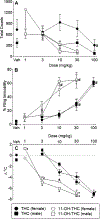Sex, species and age: Effects of rodent demographics on the pharmacology of ∆9-tetrahydrocanabinol
- PMID: 32810571
- PMCID: PMC7750258
- DOI: 10.1016/j.pnpbp.2020.110064
Sex, species and age: Effects of rodent demographics on the pharmacology of ∆9-tetrahydrocanabinol
Abstract
Cannabis edibles are becoming more common in an increasingly diverse population of users, and the impact of first pass metabolism on cannabis's pharmacological profile across age and sex is not well understood. The present study examined the impact of age, sex and rodent species on the effects of intraperitoneal (i.p.) delta-9-tetrahydrocannabinol (THC) and its primary psychoactive metabolite, 11-OH-THC, in rodent models of psychoactivity and molecular assays of cannabinoid receptor type-1 (CB1) pharmacology. Like oral THC, i.p. THC also undergoes first pass metabolism. In both species and sexes, 11-OH-THC exhibited marginally higher affinity (~1.5 fold) than THC and both served as partial agonists in [35S]GTPγS binding with equivalent potency; 11-OH-THC exhibited slightly greater efficacy in rat brain tissue. In ICR mice, 11-OH-THC exhibited greater potency than THC in assays of catalepsy (7- to 15-fold) and hypothermia (7- to 31-fold). Further, 11-OH-THC was more potent in THC drug discrimination (7- to 9-fold) in C57Bl/6 J mice, with THC-like discriminative stimulus effects being CB1-, but not CB2-, mediated. THC's discriminative stimulus also was stable across age in mice, as its potency did not change over the course of the experiment (~17 months). While sex differences in THC's effects were not revealed in mice, THC was significantly more potent in females Sprague-Dawley rats than in males trained to discriminate THC from vehicle. This study demonstrates a cross-species in the psychoactive effects of i.p. THC across sex that may be related to differential metabolism of THC into its psychoactive metabolite 11-OH-THC, suggesting that species is a crucial design consideration in the preclinical study of phytocannabinoids.
Keywords: 11-OH-THC; Age differences; Cannabinoid; Delta-9-tetrahydrocannabinol; Drug discrimination; Metabolite; Sex differences.
Copyright © 2020 Elsevier Inc. All rights reserved.
Conflict of interest statement
Conflict of Interest
None of the authors have any conflicts of interest with respect to the research described in this manuscript. The funding sources provided funding for the research, but did not otherwise influence the conduct of the experiments, writing on the manuscript, or decision to submit.
Figures





Similar articles
-
In vitro and in vivo pharmacological evaluation of the synthetic cannabinoid receptor agonist EG-018.Pharmacol Biochem Behav. 2020 Jun;193:172918. doi: 10.1016/j.pbb.2020.172918. Epub 2020 Apr 2. Pharmacol Biochem Behav. 2020. PMID: 32247816 Free PMC article.
-
Sex, THC, and hormones: Effects on density and sensitivity of CB1 cannabinoid receptors in rats.Drug Alcohol Depend. 2019 Jan 1;194:20-27. doi: 10.1016/j.drugalcdep.2018.09.018. Epub 2018 Oct 25. Drug Alcohol Depend. 2019. PMID: 30391834 Free PMC article.
-
In vitro and in vivo pharmacology of nine novel synthetic cannabinoid receptor agonists.Pharmacol Biochem Behav. 2022 Oct;220:173467. doi: 10.1016/j.pbb.2022.173467. Epub 2022 Sep 22. Pharmacol Biochem Behav. 2022. PMID: 36154844 Free PMC article.
-
Distinct pharmacology and metabolism of K2 synthetic cannabinoids compared to Δ(9)-THC: mechanism underlying greater toxicity?Life Sci. 2014 Feb 27;97(1):45-54. doi: 10.1016/j.lfs.2013.09.017. Epub 2013 Sep 29. Life Sci. 2014. PMID: 24084047 Free PMC article. Review.
-
The Chemistry and Pharmacology of Synthetic Cannabinoid Receptor Agonists as New Psychoactive Substances: Origins.Handb Exp Pharmacol. 2018;252:165-190. doi: 10.1007/164_2018_143. Handb Exp Pharmacol. 2018. PMID: 29980914 Review.
Cited by
-
Sex Differences in Tolerance to Delta-9-Tetrahydrocannabinol in Mice With Cisplatin-Evoked Chronic Neuropathic Pain.Front Mol Biosci. 2021 Jun 25;8:684115. doi: 10.3389/fmolb.2021.684115. eCollection 2021. Front Mol Biosci. 2021. PMID: 34250019 Free PMC article.
-
Sex differences and the endocannabinoid system in pain.Pharmacol Biochem Behav. 2021 Mar;202:173107. doi: 10.1016/j.pbb.2021.173107. Epub 2021 Jan 12. Pharmacol Biochem Behav. 2021. PMID: 33444598 Free PMC article. Review.
-
Sex differences in acute delta-9-tetrahydrocannabinol (Δ9-THC) response and tolerance as a function of mouse strain.Psychopharmacology (Berl). 2023 Sep;240(9):1987-2003. doi: 10.1007/s00213-023-06421-8. Epub 2023 Jul 29. Psychopharmacology (Berl). 2023. PMID: 37516707 Free PMC article.
-
Vaporized cannabis extract-induced antinociception in male vs female rats with persistent inflammatory pain.Pain. 2023 Sep 1;164(9):2036-2047. doi: 10.1097/j.pain.0000000000002902. Epub 2023 Apr 6. Pain. 2023. PMID: 37027147 Free PMC article.
-
The endocannabinoid system as a putative target for the development of novel drugs for the treatment of psychiatric illnesses.Psychol Med. 2023 Nov;53(15):7006-7024. doi: 10.1017/S0033291723002465. Epub 2023 Sep 6. Psychol Med. 2023. PMID: 37671673 Free PMC article. Review.
References
-
- Borys HK, Karler R, 1979. Cannabidiol and delta-9-tetrahydrocannabinol metabolism: In vitro comparison of mouse and rat liver crude microsome preparations. Biochem Pharmacol 28, 1553–1559. - PubMed
-
- Browne RG, Weissman A, 1981. Discriminative stimulus properties of Δ9-THC : mechanistic studies. J Clin Pharmacol 21, 227s–234s. - PubMed
Publication types
MeSH terms
Substances
Grants and funding
LinkOut - more resources
Full Text Sources
Other Literature Sources

